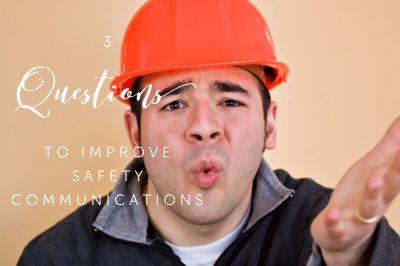Communication gets better when your intentions for communication become clearer.
 Clear, concise safety communication is critical to front-line crews and employees. As a supervisor or safety person, you need to be fully understood in your communication. There’s no room for ambiguity. There can be no doubt about what you’re trying to say and what you want them to do next.
Clear, concise safety communication is critical to front-line crews and employees. As a supervisor or safety person, you need to be fully understood in your communication. There’s no room for ambiguity. There can be no doubt about what you’re trying to say and what you want them to do next.
Too many supervisors ascend to their positions because they’ve been on the job the longest. It's not because of their communication skills. There is no direct connection between tenure (seniority) and communication. In fact, the longer you’re in the job, the more you assume others already know what they should know.
Safety people and supervisors are not required to have any schooling in either communications or management skills. But the biggest part of the job is communicating, right?
Let’s re-frame communications in a way that helps front-line supervisors and safety people. Let’s improve communications. Here are three questions that are designed to streamline your communications effectively in safety:
1What do you want to accomplish: short-term compliance or build long-term leaders? How you approach each one of these is very different. To get short-term compliance, you focus on the task in front of you and the decisions related to only that task. Nothing else enters into the communications. But if you want to build long-term safety leaders, you want employees to consider every decision they make all day long. The problem with focusing on short-term compliance is that you will have to repeat yourself again tomorrow. To build leadership, you will have to talk about things like accountability and responsibility. They are things not directly related to the task at hand. Compliance is focused on “do” or “do not.” Leadership is focused on values and attitudes. So, before you communicate, ask yourself which of the two that you want to accomplish with this conversation?
2What are the successful examples you can point to? Successful people in all walks of life look to successful mentors and coaches to inspire them. Athletes are inspired by other great athletes. Leaders are inspired by other great leaders. Writers are inspired by other great writers. You get how this works. So who are the great safety performers that would inspire your people - and you? Who is it that any one of your people could say, “I want to be just like him/her.” That’s tough in safety isn’t it? It’s because safety has historically attached itself to messages of “don’t do what I did.” But, since you never carry a grocery list of things not to buy, you look for success strategies you can copy. You want to be able to emulate those who are successful. Compliance doesn’t provide those examples. You need to identify those who are doing safety in a positive way and use them as your examples and models.
3What do you want them to do? “Be safe” is not a strong enough answer. Besides, be safe is an incomplete set of instructions. What specifically would you like your crews and employees, each of them, to do differently? And the answer should not to be the same for everyone. None of your people is exactly the same. Picture each of your crew members in your mind (you had better know them well enough). What one or two things would you like each person to do better? Then, communicate those one or two items to that person. Coach them. Mentor them. Inspire them to want more. Surely no one likes being singled out for doing it wrong or scolded to do it right. But it’s a choice that employees make when they choose to take shortcuts or choose to give the least amount of effort possible. People are better than that. They will rise to be better when they are called on their B.S. and challenged to give their best effort. So, what do you want them to do exactly. Be specific. Make it evident.
 Communication gets better when your intentions for communication become clearer. So, think about what you want to have happen. Become very clear on the kind of safety culture you’d like to contribute to. Then, get busy inspiring that. Barking orders and quoting from the rule book treats people like they’re little kids. If you want to be a professional workplace, treat them like the professionals they are. Build their performance.
Communication gets better when your intentions for communication become clearer. So, think about what you want to have happen. Become very clear on the kind of safety culture you’d like to contribute to. Then, get busy inspiring that. Barking orders and quoting from the rule book treats people like they’re little kids. If you want to be a professional workplace, treat them like the professionals they are. Build their performance.
Kevin Burns gives engaging, entertaining and inspiring speeches to front-line employees at safety meetings. He also works with supervisors and safety managers on-site or in keynote presentations at conferences. He is an expert in how to get through to people. Kevin helps organizations integrate caring for and valuing employees through their safety programs. Kevin Burns is a management consultant, safety speaker and author of "The Perfect Safety Meeting" and "Running With Scissors - 10 Reasons To Invest in Safety In Slow Times."
(c) Can Stock Photo

